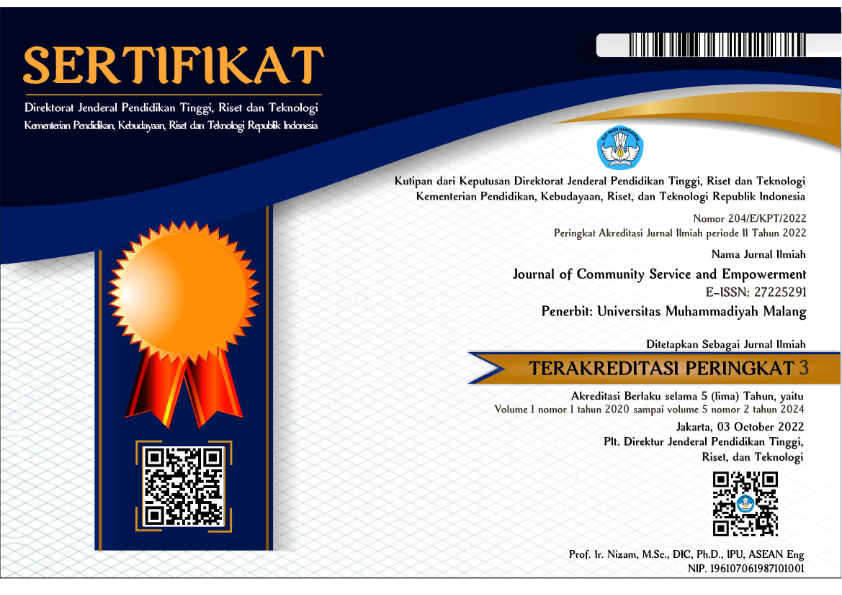Optimizing the potential of the river through the “merti kali” program to support the sustainable communities
DOI:
https://doi.org/10.22219/jcse.v4i1.24524Keywords:
creative economy, rubbish, river, technology, recreationAbstract
The development of digital technology and virtual reality has also given birth to virtual tourism innovations that have an impact on increasing the community's economy through training. This program is carried out to create virtual tourist villages, especially based on virtual tourism batik, so that batik craftsmen have more time to promote their products and the tourist aspect. The virtual tour-based batik village aims to empower the batik artisan community to be more active in utilizing digital application platforms to market their products and produce practical applications for marketing. This digital application makes it easier for buyers to find out the promotions being carried out by Bekasi batik by utilizing gadgets and taking advantage of the digital world. The training method uses a case study approach, discussion, lecture, and ends with a training evaluation. The results of the study are based on the evaluation results of the user experience of batik craftsmen in the city of Bekasi, out of 50 respondents it is found that 55% strongly agree that training materials and virtual tour systems that are socialized are easy to access, can develop digital villages based on web virtual tours and as a forum for batik promotion Bekasi city. In the aspect of achieving the goals of the Bekasi city batik craftsmen participants, out of 50 respondents the result was that 65% strongly agreed that the learning objectives of the training and virtual tour system met the expectations of the respondents. It is the hope of the training participants that the problem of marketing the virtual tour system will be a solution to expand the marketing of batik in the City of Bekasi.
Downloads
References
Arismayanti, N. K., Widyatmaja, I. G. N., & Wiraatmaja, I. W. (2017). The Establishment of Rural Tourism Based Creative Economy Kendran Village, Gianyar. Udayana Journal of Social Sciences and Humanities (UJoSSH), 1(1), 13. https://doi.org/10.24843/ujossh.2017.v01.i01.p02
Fadhil, S. (2007). Pengelolaan Sumber Daya Alam dan Lingkungan Berbasis Pengetahuan dan Kearifan Lokal (Lokal Wisdom) di Kalimantan. Jurnal Borneo Administrator, 72–92. https://doi.org/https://doi.org/10.24258/jba.v3i1.110
Goodwin, H., & Santilli, R. (2009). Community-Based Tourism: a success? Tourism Management, 11, 1–37.
Inskeep, E. (1991). Tourism Planning, and Integrated and Sustainable Development Approach ( an N. Reinhold, Ed.). New York.
International Labour Organization. (2017). Pelatihan Keterampilan Pedesaan: Manual Generik Pelatihan untuk Pemberdayaan Ekonomi Pedesaan (TREE).
Kardono, K. (2018). Condition of Water Resource in Indonesia and Its Environmental Technology. Jurnal Air Indonesia, 3(2). https://doi.org/10.29122/jai.v3i2.2331
Lindquist, A. (2016). Baltimore’s Mr. Trash Wheel. The Journal of Ocean Technology, 11–12, 28–35.
Nurfathiyah, Fera; Mara, Armen; Siata, Ratnawaty; Farida, Aulia; Lita, A. (2011). Pemanfaatan Video sebagai Media Penyebaran Inovasi Pertanian. Jurnal Pengabdian Pada Masyarakat. Retrieved from http://online-journal.unja.ac.id/index.php/jlpm/article/view/92/81
Nurhidayat, A. (2013). Komposisi timbulan limbah padat dan kualitas air sungai sugutamu pada sub-das sugutamu. FT UI.
Panggungharjo, D. (2019). Data Monografi Desa Panggungharjo Kecamatan Sewon, Kabupaten Bantul, DIY.
Qodriyatun, S. N. (2014). Meningkatkan kesejahteraan masyarakat melalui pengelolaan sampah berdasarkan UU No. 18 Tahun 2008. Aspirasi: Jurnal Masalah-Masalah Sosial, (18), 21–34. Retrieved from http://jurnal.dpr.go.id/index.php/aspirasi/article/view/450
Saju, J. A., Nawaj, S., Rubel, R., Rahman, M., & Nayan, S. B. (2020). Effectiveness of Manual Bar Screen in Separating Solid Waste from Municipal Sewers of Khulna City. Australian Journal of Engineering and Innovative Technology, 2(3), 31–41. https://doi.org/10.34104/ajeit.020.031041
Saleh, H., Surya, B., Ahmad, D. N. A., & Manda, D. (2020). The role of natural and human resources on economic growth and regional development: With discussion of open innovation dynamics. Journal of Open Innovation: Technology, Market, and Complexity, 6(4), 1–23. https://doi.org/10.3390/joitmc6040103
Suansri, P. (2003). Community based tourism handbook. In Community Based Tourism Handbook. Retrieved from https://www.mekongtourism.org/wp-content/uploads/REST-CBT-Handbook-2003.pdf
Zainul Ikhwan, R. Hamdani Harahap, Lita Sri Andayani, & Miswar Budi Mulya. (2021). Model of the Importance of Socio-Cultural in Waste Management on Penyengat Island. Lakhomi Journal Scientific Journal of Culture, 2(4), 142–147. https://doi.org/10.33258/lakhomi.v2i4.532

Downloads
Published
How to Cite
Issue
Section
License
Copyright (c) 2023 Endah Saptutyningsih, Berli Paripurna Kamiel, Dimas Putro Nugroho, Ferry Armansyah

This work is licensed under a Creative Commons Attribution-ShareAlike 4.0 International License.












